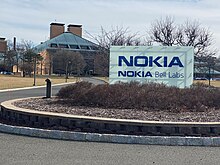Bell Laboratories
The Bell Laboratories (also Bell Labs , formerly Bell Telephone Laboratories , shortly BTL ), the former research department of the telephone company AT & T , in which numerous during the 20th century, important breakthroughs in telecommunications technology , mathematics , physics , materials science , and computer science have been achieved. Nine Nobel Prizes and several Turing Awards have been presented for research carried out at Bell Laboratories .
Today Bell Laboratories are part of Nokia's research and development division . Bell Labs is headquartered in Murray Hill , New Jersey , in the United States. Bell Labs operate several research and development facilities around the world.
The Bell Labs are organizationally divided into three divisions: Research , Systems Technology and Development .
Research gained fundamental knowledge for telecommunications from the fields of mathematics , physics , materials research and computer science .
In Development, the largest division, the hardware and software were developed with which the telecommunication network of the Bell system was built.
history
Bell Telephone Laboratories Inc. was founded in 1925 by Walter Gifford (later President of AT&T ) as a separate unit for the research and development work of Western Electric . Frank B. Jewett became the first president . Western Electric and AT&T were equal shareholders. The main task was to develop central offices for Western Electric that were sold to companies using the Bell Telephone System.
Military projects, such as the construction of the Nike rocket , were later supported.
In 1996, AT&T spun off Bell Labs, along with most of the equipment manufacturing, into the new company Lucent Technologies . AT&T retained a smaller number of researchers, which formed the AT&T Laboratories .
With the takeover of Alcatel-Lucent by Nokia in 2016, Bell-Labs also joined Nokia.
- Milestones
- 1926 Proof of the diffraction of electrons on crystals by Clinton Davisson and Lester Germer . Davisson received the Nobel Prize in Physics for this in 1937 .
- In 1932, Karl Guthe Jansky discovered that radio waves were being emitted from the center of our galaxy while he was researching the causes of noise in long-range radio links - this was the beginning of radio astronomy .
- from 1936 Hendrik Wade Bode ( Bode diagram ) worked at Bell Labs. In April 1945 he published the book " Network Analysis and Feedback Amplifier Design ".
- In 1940 George Stibitz demonstrated the Complex Number Calculator he had developed at Bell Labs , an electrical relay-based calculator for complex numbers remotely controlled over a telephone line at a meeting of the American Mathematical Society .
- From 1943 to 1945, other relay computers followed for anti-aircraft targeting and ballistic calculations.
- The first working bipolar transistor was built in 1947 in the research group led by John R. Pierce at Bell Laboratories and named by him as such. The scientists John Bardeen , William Bradford Shockley , and Walter Houser Brattain received the 1956 Nobel Prize in Physics for this.
- Claude Shannon , a mathematician at Bell Labs in 1948 published The Mathematical Theory of Communication in the Bell System Technical Journal, while drawing on earlier findings of Harry Nyquist and Ralph Hartley in the field of information theory was based.
- In 1953, Daryl Chapin , Calvin Souther Fuller and Gerald Pearson developed and produced the first technically interesting silicon solar cells with over 4% efficiency at Bell Labs (one even had 6% efficiency). In doing so, they built on many new developments in recent years.
- In 1957, Max Mathews developed the first version of his MUSIC-N program for composing computer music.
- 1960, barely six months after the first laser by Theodore Maiman , the group of Ali Javan the helium-neon laser ago, it is the first gas laser .
- In 1962, Gerhard M. Sessler and James Edward Maceo West invented the electret microphone .
- In 1964, Arno Penzias and Robert Woodrow Wilson discovered the cosmic microwave background , predicted by George Gamow as a holdover from the hot early phases of the universe. Penzias and Wilson received the Nobel Prize in Physics for this in 1978.
- 1964 Chandra Kumar N. Patel develops the carbon dioxide laser, a laser beam source with high cw power and high efficiency.
- In 1969, Willard Boyle and George E. Smith developed the CCD sensor , which today is mainly used in digital cameras. For this they also received the Nobel Prize in Physics in 2009.
- End of 1960 developed John R. Arthur and Alfred Y. Cho , the molecular beam epitaxy ( English molecular beam epitaxy, MBE ) for depositing monocrystalline layer systems which are the basis for today's optoelectronics form.
- From the late 1960s, Bell Labs were the origin of the Unix operating system and the C programming language , developed by Dennis Ritchie and Ken Thompson in the early 1970s , as well as its object-oriented extension C ++ by Bjarne Stroustrup in the 1980s . The statistical programming language S also originated from Bell Labs.
literature
- Jon Gertner: The Idea Factory: Bell Labs and the Great Age of American Innovation . Penguin Books, New York 2012, ISBN 978-1-59420-328-2 .
Web links
- Bell Labs website (English)
Individual evidence
- ↑ Bell Labs website. Retrieved September 11, 2019 .
- ↑ Bell Labs in the Engineering and Technology History Wiki
- ↑ Jürgen Berke : Fusion with Alcatel-Lucent. This is the new Nokia group. In: Wirtschaftswoche . January 13, 2016, accessed March 2, 2016 .
Coordinates: 40 ° 41 ′ 0.3 ″ N , 74 ° 24 ′ 2.7 ″ W.


